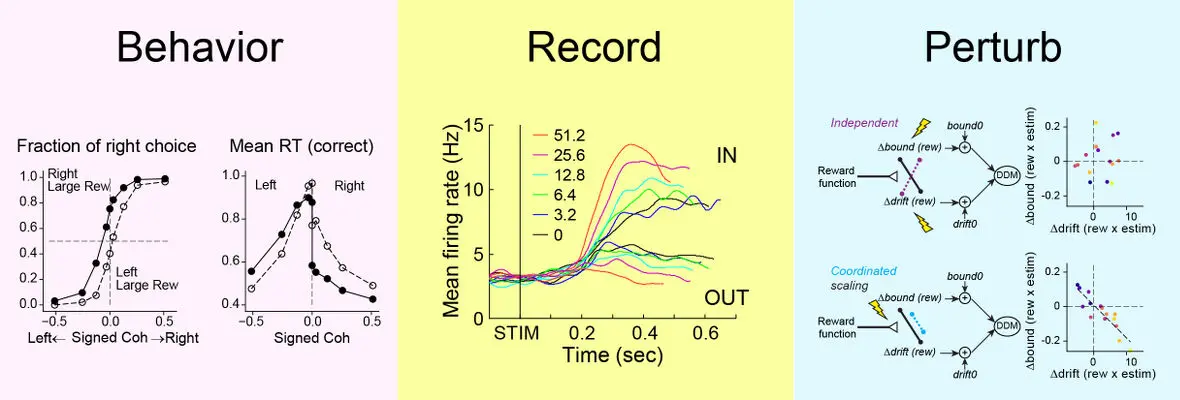Research
Decision-making is a computationally demanding process that requires the brain to interpret incoming sensory information in the context of goals, expectations, preferences, and other factors. In other words, the brain needs to combine sensory and contextual information, each with its own forms of uncertainty, to reach a single decision to guide behavior. The ability to properly incorporate contextual information is crucial for our well-being: solely relying on external sensory information leads to rigid, machine-like behavior; excessively relying on contextual information leads to compulsive decisions not based on the sensory reality. Our research efforts focus on how the brain implements the neural computations that are needed to combine uncertain visual and reward context information, particularly in the associative basal ganglia loop.
We are particularly interested in how uncertain visual input is combined with reward expectation to form a categorical decision that guides actions. We incorporate two well-known tasks, the random-dot visual motion direction discrimination and asymmetric choice-reward association tasks, to manipulate the quality of visual input and biased reward expectation. We analyze subjects' performance (choice and reaction time) on this hybrid task to infer the underlying computations. In addition to descriptive statistics, we also examine the performance within a theoretical framework (drift-diffusion model DDM) to examine several related questions:
- Do the subjects use both visual and reward information?
- Do the subjects combine these information appropriately?
- Can we infer the optimizing goal(s) of the subjects?
- Can we infer the subjects' general strategy?
- Can we infer the underlying computations in the drift-diffusion framework?
Answers to these questions are crucial for relating any neural activity to decision behavior.
We are particularly interested in the contributions of the basal ganglia. The basal ganglia pathways consist of three macroscopic loops: motor, associative and limbic loops. We focus on the associative loop as it is a good candidate for linking different sources of input to motor output, with rich representations of diverse types of information including reward expectation, quality of visual input and saccade choice. We are currently examining how the caudate nucleus (a part of the striatum) and frontal eye field (a part of the frontal cortex) contribute to the formation and evaluation of decisions that combine both visual motion input and information about unequal reward associations, which then guide saccades to appropriate visual targets.
We use a combination of behavioral, neurophysiological and computational techniques to address these questions.
A typical project involves the following steps:
- Design a task
- Train monkey subjects on the task
- Analyze task performance to infer the underlying computations
- Perform single-unit recordings in the brain region of interest
- Relate recorded activity to certain features of behavior and/or inferred computations
- Perturb activity in the brain region of interest to further examine the likely contribution of neural activity to behavior


